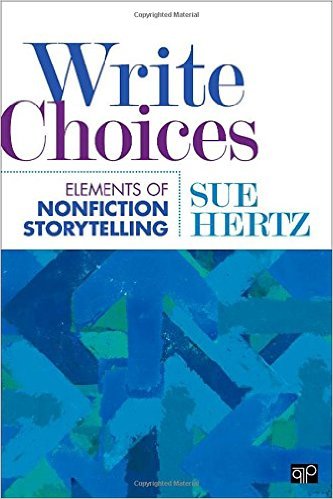 I don’t think I’ll ever feel comfortable calling myself a writer. Despite publishing stories and articles and teaching college-level writing for six years, I still balk when family members or friends try to introduce me as a writer. Maybe this hesitancy explains my almost Golum-like obsession with craft books.
I don’t think I’ll ever feel comfortable calling myself a writer. Despite publishing stories and articles and teaching college-level writing for six years, I still balk when family members or friends try to introduce me as a writer. Maybe this hesitancy explains my almost Golum-like obsession with craft books.
I love reading craft books. I read to learn how other writers tick. I read to see how weird my writing habits are compared to others’. I read to find that one piece of advice that will turn me into a real writer. I read, to be totally honest, to avoid writing.
Write Choices: Elements of Nonfiction Storytelling by Sue Hertz (CQ Press, March 2015) is, as the title suggests, focused on nonfiction storytelling and is perfect for writers who are new to the genre. This book would not be out of place in an intro to nonfiction course and, indeed, seems to be intended for use as a textbook.
Hertz, a former journalist and associate professor of English and nonfiction writing at the University of New Hampshire, is a knowledgeable guide to the world of nonfiction. In the book’s preface, she notes that “emerging writers feel often overwhelmed” by “the seemingly infinite variety of ways to tell true stories” (xiii), so instead of focusing on types of nonfiction storytelling (essay, profile, memoir), Hertz frames Write Choices as a “commonsense approach [to] the universal elements shared by all true stories told with a narrative arc” (xiv). Novice writers are introduced to the tools they can use for any type of nonfiction writing, though Hertz assumes that her readers are not so new as to be unfamiliar with the most common nonfiction genres.
The book is divided into seven chapters—“What’s the Big Idea?”, “What’s the Form?”, “What’s the Content?”, “What’s the Focus?”. “What’s the Structure?”, “What are the Components?”, and “Pulling it all Together”—that lead the reader chronologically through the process of writing a nonfiction piece. The chapters are broken down into smaller chunks, often ending with writing exercises to emphasize key ideas. For example, in the chapter on content, Hertz encourages the reader to write a scene based on a day spent shadowing a person with an interesting job, while in the chapter on putting a piece together, Hertz offers a checklist for revision that included questions like, “Is the meaning/focus clear?” and “Does the piece have a strong point of view?” (208).
In addition to clear organization and inspiring exercises, Hertz punctuates the lessons in each chapter with examples, both from her own experiences as a writer and teacher and from other well-known nonfiction writers, like John McPhee, Tracy Kidder, and Kate Bolick. It can be a little disconcerting reading part of an essay or article out of context, but the chapter-by-chapter references make it easy to track down and read the full piece, which is something I did frequently.
Hertz also enhances the chapters with sections called “Challenging Choices,” where a writer describes how he or she decided to proceed at a particularly tough point in the writing process. Each chapter also included a section called “Web Choices,” which describes choices involved in creating multimedia to augment digital prose narratives. These additions enrich Hertz’s advice and give the reader insight into other writers’ creative process.
Even though I am a big fan of craft books, I rarely put down a book about writing and actually write. Write Choices is the exception. After reading the first chapter, I started brainstorming ideas for an essay, and I’ll continue to refer to this great little book as I write it.
Five out of five stars.
[boxer set=”phillips”]


